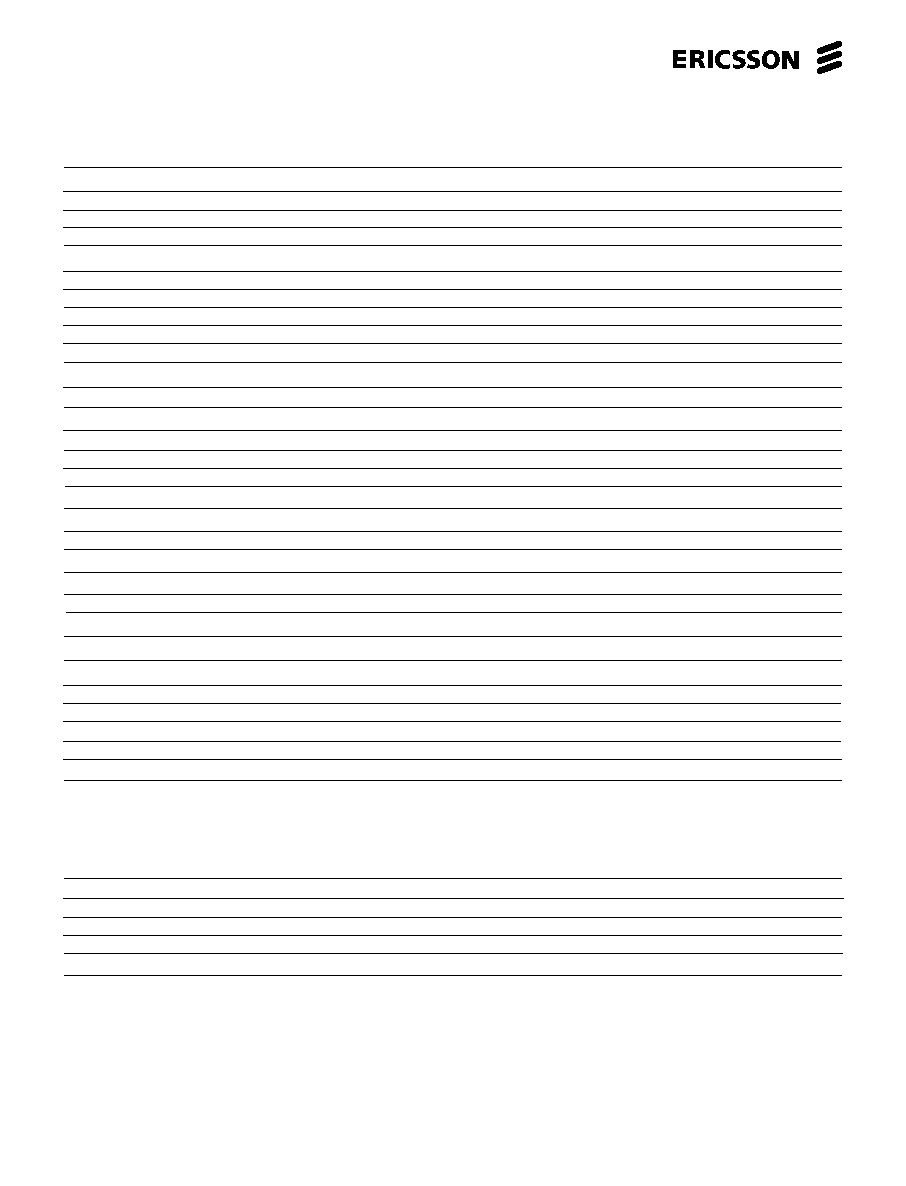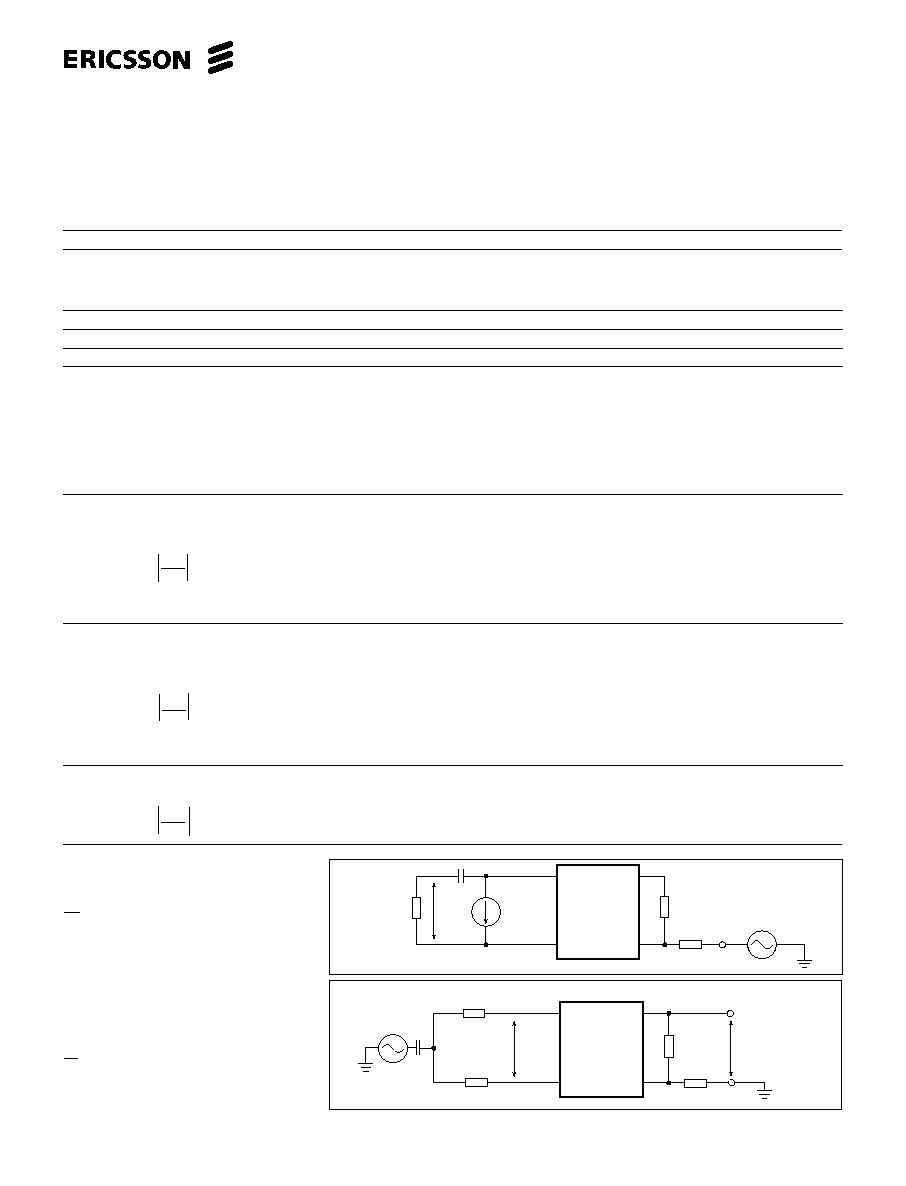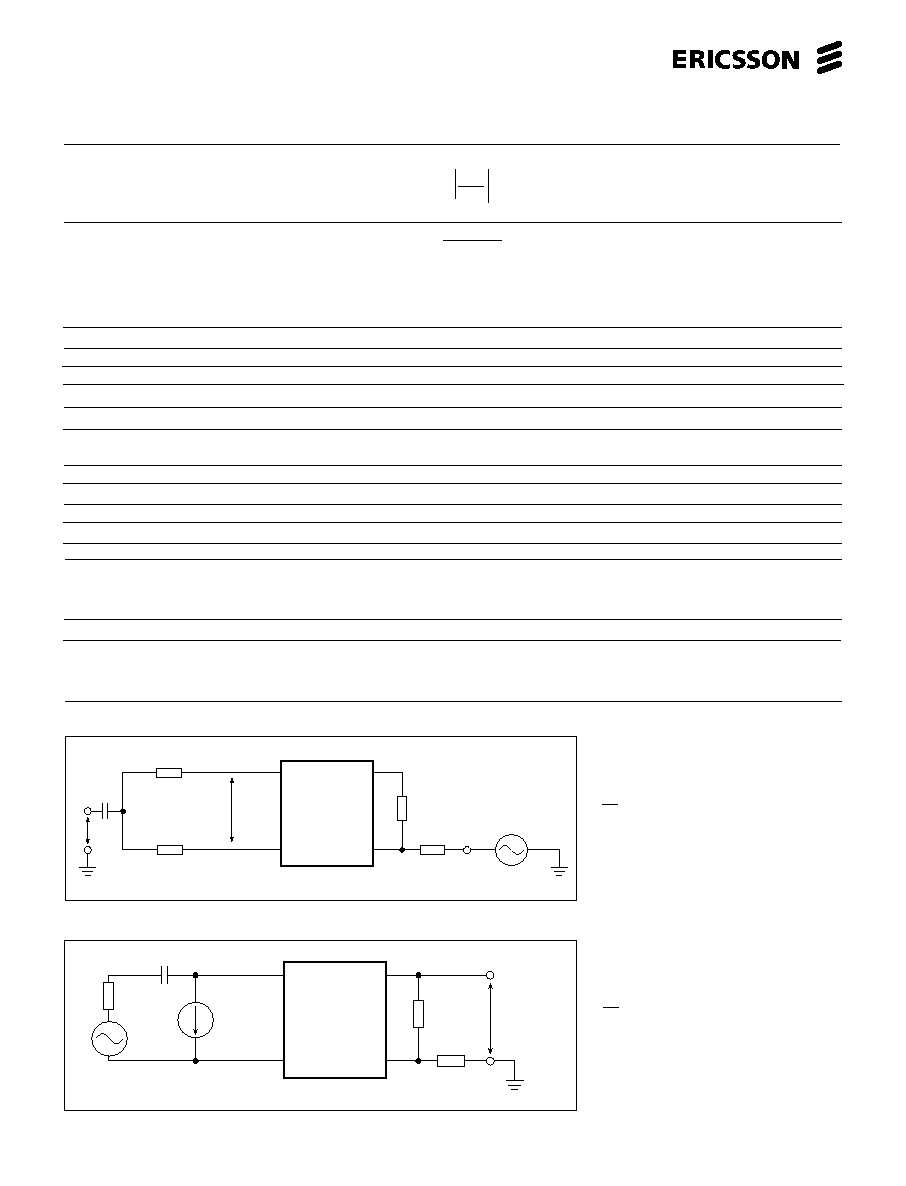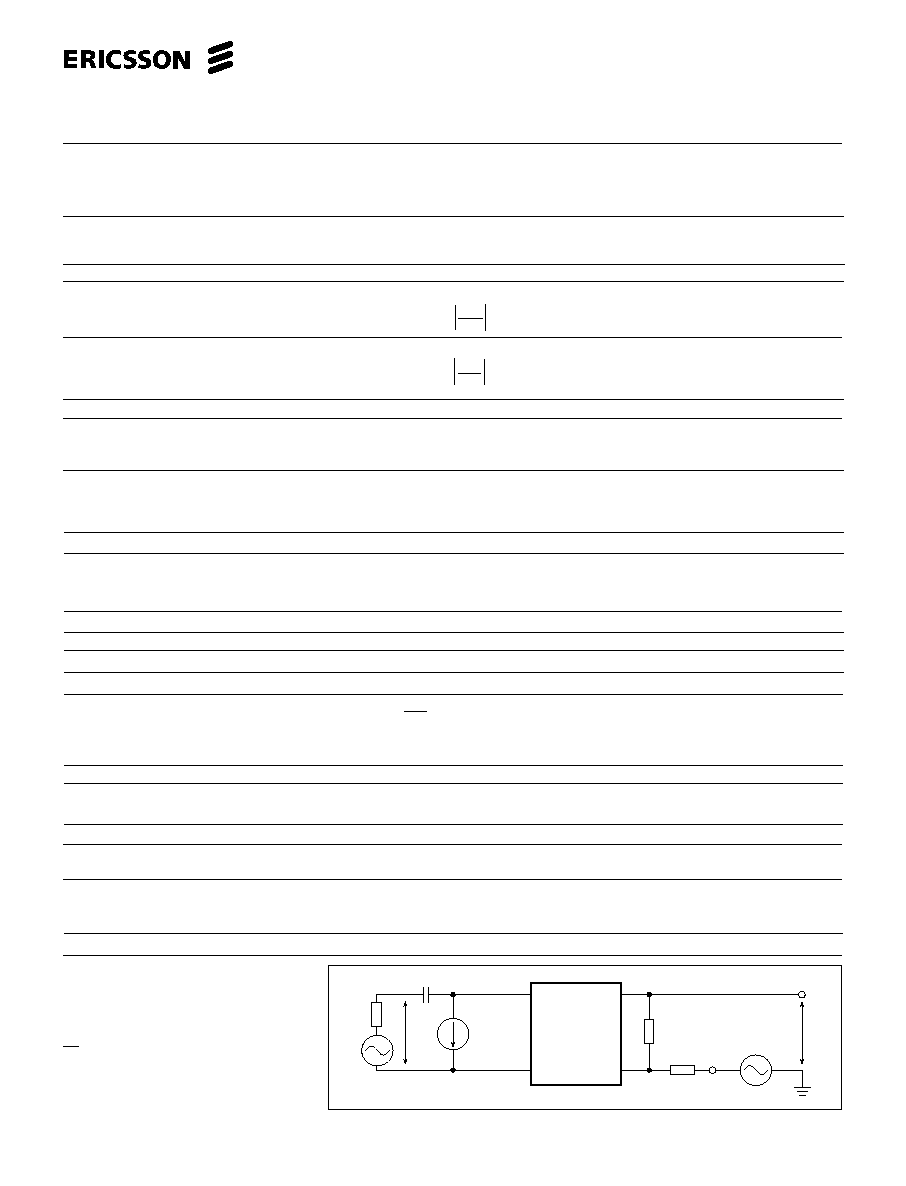
Description
The PBL 386 65/2 Subscriber Line Interface Circuit (SLIC) is a 90 V bipolar integrated
circuit for use in DLC, Central Office and other telecommunications equipment. The
PBL 386 65/2 has been optimized for low total line interface cost and a high degree
of flexibility in different applications.
The PBL 386 65/2 emulates a transformer equivalent dc-feed, programmable
between 2x25
and 2x900
, with short loop current limiting adjustable to max
65 mA.
A second lower battery voltage may be connected to the device to reduce short
loop power dissipation. The SLIC automatically switches between the two battery
supply voltages without need for external components or external control.
The SLIC incorporates loop current, ground key and ring trip detection functions. The
PBL 386 65/2 is compatible with loop start and ground start signalling.
Two- to four-wire and four- to two-wire voice frequency (vf) signal conversion is
accomplished by the SLIC in conjunction with either a conventional CODEC/filter or
with a programmable CODEC/filter, e.g. SLAC, SiCoFi, Combo II. The programmable
line terminating impedance could be complex or real to fit every market.
Longitudinal line voltages are suppressed by a feedback loop in the SLIC and the
longitudinal balance specifications meet the DLC requirements.
The PBL 386 65/2 package is 28-pin PLCC and 28-pin SSOP.
Figure 1. Block diagram.
May 2000
PBL 386 65/2
Subscriber Line
Interface Circuit
Key Features
∑ Selectable overhead voltage principle
≠ All adaptive: The overhead voltage
follows 0.6
Peak
V < signals < 6.2V
Peak
.
≠ Semi adaptive: The overhead voltage
follows 3.1V
Peak
< signals < 6.2V
Peak
.
∑ Metering 2.2 V
rms
∑ High and low battery with automatic
switching
∑ Battery supply as low as -10 V
∑ Only +5 V in addition to GND
and battery (VEE optional)
∑ 39 mW on-hook power dissipation in
active state
∑ Long loop battery feed tracks V
Bat
for
maximum line voltage
∑ 44V open loop voltage @ -48V
battery feed
∑ Constant loop voltage for line
leakage <5 mA
∑ On-hook transmission
∑ Full longitudinal current capability
during on-hook
∑ Programmable loop & ring-trip detector
threshold
∑ Ground key detector
∑ Analog temperature guard
∑ Tip open state with ring ground detector
∑ Silent polarity reversal
∑ Line voltage measurement
∑ -40
∞
C to +85
∞
C ambient temperature
range
28-pin PLCC and 28-pin SSOP.
PBL
386 65/2
VF Signal
Transmission
Off-hook
Detector
Line Feed
Controller
and
Longitudinal
Signal
Suppression
Ring Trip
Two-wire
Interface
Input
Decoder and
Control
C1
C2
DET
REF
LP
VTX
RSN
DT
DR
TIPX
HP
RINGX
VCC
VBAT2
VBAT
AGND
C3
BGND
Comparator
Ground Key
Detector
Ring Relay
Driver
RRLY
PLD
PLC
PSG
TS
AOV
VEE
(Optional)
Preliminary
1
PBL 386 65/2

PBL 386 65/2
2
Preliminary
Maximum Ratings
Parameter
Symbol
Min
Max
Unit
Temperature, Humidity
Storage temperature range
T
Stg
-55
+150
∞
C
Operating temperature range
T
Amb
-40
+110
∞
C
Operating junction temperature range, Note 1
T
J
-40
+140
∞
C
Power supply, -40
∞
C
T
Amb
+85
∞
C
V
CC
with respect to A/BGND
V
CC
-0.4
6.5
V
V
EE
with respect to A/BGND
V
EE
V
Bat
0.4
V
V
Bat
with respect to A/BGND, continuous
V
Bat
-75
0.4
V
V
Bat
with respect to A/BGND, 10 ms
V
Bat
-80
0.4
V
V
Bat2
with respect to A/BGND
V
Bat2
V
Bat
0.4
V
Power dissipation
Continuous power dissipation at T
Amb
+85
∞
C
P
D
1.5
W
Ground
Voltage between AGND and BGND
V
G
-5
VCC
V
Relay Driver
Ring relay supply voltage
BGND +13
V
Ring relay current
75 mA
Ring trip comparator
Input voltage
V
DT
, V
DR
V
Bat
V
CC
V
Input current
I
DT
, I
DR
-5
5
mA
Digital inputs, outputs (C1, C2, C3, DET)
Input voltage
V
ID
-0.4
V
CC
V
Output voltage (DET not active)
V
OD
-0.4
V
CC
V
Output current (DET)
I
OD
30
mA
TIPX and RINGX terminals, -40
∞
C < T
Amb
< +85
∞
C, V
Bat
= -50V
Maximum supplied TIPX or RINGX current
I
TIPX
, I
RINGX
-110
+110
mA
TIPX or RINGX voltage, continuous (referenced to AGND), Note 2
V
TA
, V
RA
V
Bat
2
V
TIPX or RINGX, pulse < 10 ms, t
Rep
> 10 s, Note 2
V
TA
, V
RA
V
Bat
- 20
5
V
TIPX or RINGX, pulse < 1
µ
s, t
Rep
> 10 s, Note 2
V
TA
, V
RA
V
Bat
- 40
10
V
TIP or RING, pulse < 250 ns, t
Rep
> 10 s, Note 3
V
TA
, V
RA
V
Bat
- 70
15
V
Recommended Operating Condition
Parameter
Symbol
Min
Max
Unit
Ambient temperature
T
Amb
-40
+85
∞
C
V
CC
with respect to AGND
V
CC
4.75
5.25
V
V
EE
with respect to AGND
V
EE
V
Bat
-4.75
V
V
Bat
with respect to BGND
V
Bat
-58
-10
V
V
Bat2
with respect to BGND
V
Bat
-10
V
Notes
1.
The circuit includes thermal protection. Operation above max. junction temperature may degrade device reliability.
2.
A diode in series with the VBat input increases the permitted continuous voltage and pulse < 10 ms to -85 V. A pulse
1
µ
s is increased to the greater of |-70V| and |VBat -40V|.
3.
R
F1
, F
R2
20
is also required. Pulse is supplied to TIP and RING outside R
F1
, F
R2
.

PBL 386 65/2
3
Preliminary
Electrical Characteristics
-40
∞
C
T
Amb
+85
∞
C, V
CC
= +5V
±
5 %, V
EE
= -5V
±
5%, V
Bat
= -58V to -40V, R
LC
=18.7k
, I
L
= 27 mA, Z
L
= 600
, R
F1
, R
F2
=0
,
R
Ref
= 15k
, C
HP
= 68nF, C
LP
=0.33
µ
F, R
T
= 120 k
, R
SG
= 24 k
, R
RX
= 120 k
, AOV- and V
Bat2
pin not connected, unless
otherwise specified. Current definition: current is positive if flowing into a pin.
Ref
Parameter
fig
Conditions
Min
Typ
Max
Unit
Two-wire port
Overload level, V
TRO
,I
LDC
10 mA
2
Active state
1% THD, Note 1
3.1
V
Peak
On-Hook, I
LDC
5 mA
1.4
V
Peak
Input impedance, Z
TR
Note 2
Z
T
/200
Longitudinal impedance, Z
LoT
, Z
LoR
0 < f < 100 Hz
20
35
/wire
Longitudinal current limit, I
LoT
, I
LoR
active state
28
mA
rms
/wire
Longitudinal to metallic balance, B
LM
3
IEEE standard 455-1985, Z
TRX
=736
, active state
Normal polarity:
0.2 kHz < f < 1.0 kHz, T
amb
0-70
∞
C
63
dB
1.0 kHz < f < 3.4 kHz, T
amb
0-70
∞
C
58
dB
0.2 kHz < f < 1.0 kHz, T
amb
-40-85
∞
C
58
dB
1.0 kHz < f < 3.4 kHz, T
amb
-40-85
∞
C
54
dB
Reverse polarity:
0.2 kHz < f < 3.4 kHz, T
amb
-40-85
∞
C
54
dB
Longitudinal to metallic balance, B
LME
3
Active state
Normal polarity:
0.2 kHz < f < 1.0 kHz, T
amb
0-70
∞
C
63
dB
E
LO
1.0 kHz < f < 3.4 kHz, T
amb
0-70
∞
C
58
dB
B
LME
= 20 ∑ Log
0.2 kHz
f
1.0 kHz, T
amb
-40-85
∞
C
58
dB
V
TR
1.0 kHz < f < 3.4 kHz, T
amb
-40-85
∞
C
54
dB
Reverse polarity:
0.2 kHz < f < 3.4 kHz, T
amb
-40-85
∞
C
54
dB
Longitudinal to four-wire balance, B
LFE
3
Active state
Normal polarity:
0.2 kHz < f < 1.0 kHz, T
amb
0-70
∞
C
69
dB
E
LO
1.0 kHz < f < 3.4 kHz, T
amb
0-70
∞
C
64
dB
B
LFE
= 20 ∑ Log
0.2 kHz
f
1.0 kHz, T
amb
-40-85
∞
C
64
dB
V
TX
1.0 kHz < f < 3.4 kHz, T
amb
-40-85
∞
C
60
dB
Reverse polarity:
0.2 kHz < f < 3.4 kHz, T
amb
-40-85
∞
C
54
dB
Metallic to longitudinal balance, B
MLE
4
Active state
0.2 kHz < f < 3.4kHz
40
dB
V
TR
B
MLE
= 20 ∑ Log
V
LO
Figure 2. Overload level, V
TRO
, two-wire
port
1
<< R
L
, R
L
= 600
C
R
T
= 120 k
, R
RX
= 120 k
Figure 3. Longitudinal to metallic (B
LME
)
and Longitudinal to four-wire (B
LFE
)
balance
1
<< 150
, R
LR
= R
LT
= R
L
/2= 300
C
R
T
= 120 k
, R
RX
= 120 k
PBL 386 65/2
TIPX
RINGX
RSN
VTX
R
T
R
RX
E
RX
R
L
V
TRO
I
LDC
C
PBL 386 65/2
TIPX
RINGX
RSN
VTX
R
T
R
RX
V
TX
R
LT
C
V
TR
R
LR
E
Lo

PBL 386 65/2
4
Preliminary
Parameter
fig
Conditions
Min
Typ
Max
Unit
Four-wire to longitudinal balance, B
FLE
4
Active state
E
RX
B
FLE
= 20 ∑ Log
V
Lo
0.2 kHz < f < 3.4 kHz
40
dB
Two-wire return loss, r
|Z
TR
+ Z
L
|
r = 20 ∑ Log
|Z
TR
- Z
L
|
0.2 kHz < f < 0.5 kHz
25
dB
0.5 kHz < f < 1.0 kHz
27
dB
1.0 kHz < f < 3.4 kHz, Note 3
23
dB
TIPX idle voltage, V
Ti
active, I
L
< 5 mA
- 1.5
V
RINGX idle voltage, V
Ri
active, I
L
< 5 mA
V
Bat
+
2.7
V
RINGX idle voltage, V
Ri
tip open, I
L
< 5 mA
V
Bat
+
3.0
V
V
TR
active, I
L
< 5 mA
V
Bat
+4.2
V
Four-wire transmit port (VTX)
Overload level, V
TXO
, I
L
10 mA
5
Load impedance > 20 k
,
1.55
V
Peak
On hook I
L
5 mA
1% THD, Note 4
0.7
V
Peak
Output offset voltage,
V
TX
-60
60
mV
Output impedance, z
TX
0.2 kHz < f < 3.4 kHz
5
20
Four-wire receive port (RSN)
Receive summing node (RSN) dc voltage
I
RSN
= 0 mA
-25
GND
+25
mV
Receive summing node (RSN) impedance
0.2 kHz < f < 3.4 kHz
10
50
Receive summing node (RSN)
0.3 kHz < f < 3.4 kHz
current (I
RSN
) to metallic loop current (I
L
)
400
ratio
gain,
RSN
Frequency response
Two-wire to four-wire, g
2-4
6
relative to 0 dBm, 1.0 kHz. E
RX
= 0 V
0.3 kHz < f < 3.4 kHz
-0.15
0.15
dB
f = 8.0 kHz, 12 kHz, 16 kHz
-0.5
0
+0.1
dB
Figure 4. Metallic to longitudinal and
four-wire to longitudinal balance
1
<< 150
, R
LT
= R
LR
= R
L
/2
=300
C
R
T
= 120 k
, R
RX
= 120 k
Figure 5. Overload level, V
TXO
, four-wire
transmit port
1
<< R
L
, R
L
= 600
C
R
T
= 120 k
, R
RX
= 120 k
Ref
PBL 386 65/2
TIPX
RINGX
RSN
VTX
R
T
R
RX
E
RX
R
LT
C
V
TR
R
LR
V
Lo
PBL 386 65/2
TIPX
RINGX
RSN
V
TX
R
T
R
RX
R
L
I
LDC
C
E
L
V
TXO

PBL 386 65/2
5
Preliminary
Four-wire to two-wire, g
4-2
6
relative to 0 dBm, 1.0 kHz. E
L
= 0 V
0.3 kHz < f < 3.4 kHz
-0.15
0.15
dB
f = 8 kHz, 12 kHz,
-1.0
-0.2
0
dB
16 kHz
-1.0
-0.3
0
dB
Four-wire to four-wire, g
4-4
6
relative to 0 dBm, 1.0 kHz. E
L
= 0 V
0.3 kHz < f < 3.4 kHz
-0.15
0.15
dB
Insertion loss
Two-wire to four-wire, G
2-4
6
0 dBm, 1.0 kHz, Note 5
V
TX
G
2-4
= 20 ∑ Log
,E
RX
= 0
V
TR
-6.22
-6.02
-5.82
dB
Four-wire to two-wire, G
4-2
6
0 dBm, 1.0 kHz, Notes 5, 6
V
TR
G
4-2
= 20 ∑ Log
,E
L
= 0
E
RX
-0.2
0.2
dB
Gain tracking
Two-wire to four-wire R
LDC
2k
6
Ref. -10 dBm, 1.0 kHz, Note 7
-40 dBm to +3 dBm
-0.1
0.1
dB
-55 dBm to -40 dBm
-0.2
0.2
dB
Four-wire to two-wire R
LDC
2k
6
Ref. -10 dBm, 1.0 kHz, Note 7
-40 dBm to +3 dBm
-0.1
0.1
dB
-55 dBm to -40 dBm
-0.2
0.2
dB
Noise
Idle channel noise at two-wire
C-message weighting
7
12
dBrnC
(TIPX-RINGX)
Psophometrical weighting
-83
-78
dBmp
Note 8
Harmonic distortion
Two-wire to four-wire
6
0 dBm, 1.0 kHz test signal
-50
dB
Four-wire to two-wire
0.3 kHz < f < 3.4 kHz
-50
dB
Battery feed characteristics
Constant loop current, I
Lconst
15
I
LProg
= 500
R
LC
18 < I
LProg
< 65 mA
0.92 I
LProg
I
LProg
1.08 I
LProg
mA
Tip open state TIPX current, I
Leak
7
S = closed; R = 7 k
-100
µ
A
Tip open state RINGX current, I
LRTO
7
R
LRTO
= 0
, V
Bat
= -48V
I
L
mA
R
LRTO
= 2.5 k
, V
Bat
= -48V
17
mA
Tip open state RINGX voltage, V
RTO
7
I
LRTO
< 23 mA
V
Bat
+ 5.8
V
Tip voltage (ground start)
7
Active state, Tip lead open (S open),
-4
-2.5
-
V
Ring lead to ground through 150
Tip voltage (ground start)
7
Active state, tip lead to -48 V
-6
-3.1
-
V
through 7 k
(S closed), Ring
lead to ground through 150
Open circuit state loop current, I
LOC
R
L
= 0
-100
0
100
µ
A
Ref
Parameter
fig
Conditions
Min
Typ
Max
Unit
Figure 6.
Frequency response, insertion loss,
gain tracking.
1
<< R
L
, R
L
= 600
C
R
T
= 120 k
, R
RX
= 120 k
PBL 386 65/2
TIPX
RINGX
RSN
VTX
R
T
R
RX
E
RX
R
L
V
TR
I
LDC
C
E
L
V
TX




